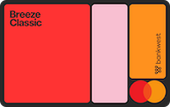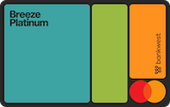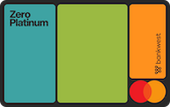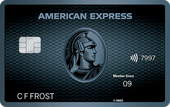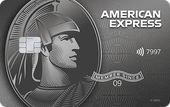
The lowdown.
What is a low interest rate credit card?
Low interest rate credit cards typically come with low ongoing interest rates on purchases and sometimes cash advances. Many offer introductory interest rates as low as 0% p.a. on purchases and balance transfers.
Generally, credit cards with ongoing purchase rates below 15% p.a. are classified as being low rate cards. 20% p.a. is around about the average for purchases. The trade-off is that cards with higher interest rates typically offer additional benefits to customers such as earning rewards or frequent flyer points.
Low rate cards are available for personal, business, and corporate users.

What is the lowest interest credit card available in Australia?
As of right now, the lowest rate credit card in Australia is the Unity Bank Low Rate Visa Credit Card or the G&C Mutual Bank Low Rate Visa Credit Card, both with an interest rate of 7.49%.

Types of low rate credit cards
Each credit card has different interest rates, and therefore to consider apart from the ongoing purchase rate.
1. Low rate balance transfer credit cards
This is the interest rate applied to balances you transfer from another credit card to your new card. It usually lasts for a specific promotional period, after which the interest rate reverts to the standard purchase rate.
Balance transfers can be an effective way to manage existing debt if repaid within the promotional period and are widely available. We consider 0% p.a. the standard for a balance transfer offer.
2. Low rate cash advance credit cards
This is the interest rate charged on cash withdrawals from ATMs using your credit card. It’s typically the same as or slightly higher than the purchase rate. The cash advance rate also applies to transactions classified as "cash-like," such as buying traveller's cheques or funding a money transfer order.
Unlike purchase transactions, cash advances often incur interest immediately without any interest-free period. Anything around 10% p.a. is considered a low rate in terms of cash advances.
3. Low ongoing rate purchase credit cards
The purchase rate applies to purchases made with your card, such as in-store or online transactions. Many cards also have an interest-free period, usually ranging from 44 to 55 days. This means if you pay off your balance in full by the due date, no interest is charged on purchases made during that period.
Low rate credit cards typically offer ongoing purchase rates below 15% p.a.
4. Low introductory rate purchase credit cards
Some cards may also offer an introductory purchase rate for a limited time, after which the standard rate takes effect.
Competitive introductory offers on purchases are 0% p.a. and last for 12 months or longer, reverting to a low ongoing rate.

What is the cheapest credit card?
The "cheapest credit card" for you depends largely on how you plan to use the card. Key factors to consider may include purchase interest rates, interest-free days, and fees.
Low rate credit cards typically have purchase interest rates below 15% p.a., which can help reduce costs for those who carry a balance. These cards often include interest-free periods, usually ranging from 44 to 55 days, allowing cardholders to avoid interest charges if the balance is paid off in full within the specified time frame.
However, the credit card with the lowest interest rate isn’t necessarily the "cheapest." For example, a card with no interest rate could end up costing more than one with a 20% interest rate, depending on its structure and how it’s used. Fees and how the card is managed play a significant role in its overall cost.
Some no-interest credit cards, for instance, charge a monthly fee instead of interest, which may increase as your credit limit grows. Similarly, while low interest rate cards often have annual fees ranging from $0 to $100, some may come with higher fees, especially if additional features are included. Other costs, such as late payment penalties, cash advance charges, and foreign transaction fees, can also add up, depending on your usage.
On the other hand, a card with a higher interest rate but no annual fee could potentially cost nothing if you consistently pay off the balance in full each month, avoiding interest charges altogether.

Expert opinion
How to compare low interest rate and rewards credit cards

Credit Card Compare credit card editor, Vidhu Bajaj, explains the trade-off of low interest rate credit cards:
Lower interest rates on credit cards can help reduce the cost of borrowing, but there’s often a trade-off. These cards generally focus on affordability and often come with fewer perks, such as no rewards programs, fewer complimentary insurances, and limited premium features. And while many low rate credit cards have lower annual fees, this isn’t always the case. Some may have slightly higher fees if they include additional features like balance transfer offers or longer interest-free periods.

Who are low interest credit cards best suited to?
In some cases, people with limited credit histories or lower incomes might find low rate credit cards to be a more accessible option due to their simplified structure and affordability. These cards are often associated with fewer perks, which can make them less risky for issuers and therefore potentially easier to qualify for. However, eligibility typically depends on the issuer’s requirements, such as minimum income thresholds and credit score criteria.
Low rate credit cards generally appeal to budget-conscious people (first time card users, students, pensioners) who prioritise managing costs over accessing premium features, such as earning rewards points.
Their lower rates on purchase can help reduce the cost of borrowing compared to standard or premium cards.
They may also be suitable for those making occasional large purchases and planning to repay them over time, as the reduced interest rates can lower the cost of carrying a balance. And cards with an interest-free balance transfer can be useful for paying off high-interest debt.

What to consider before applying for a low interest rate credit card
There's more to a credit card than the headline introductory offer. Here are some key things to consider before applying for a low rate credit card to make an informed decision.
- Interest rate. If the card has a low rate for an introductory period, make sure you check what that rate reverts to when the offer expires.
- Fees and charges. Some low rate cards have low or no annual fees, but other fees — like the foreign transaction fee — could be on the higher side.
- Interest-free days. Many low rate credit cards also offer interest-free days on purchases, usually up to 55 days, but only if you pay off your balance in full each month. More interest-free days is generally considered better, giving you more flexibility.
- Your spending habits. If you consistently pay off your balance in full each month, you might not save that much with a low rate credit card as you're avoiding interest charges altogether. Depending on your requirements, a card that earns rewards might be worth considering instead.

Are low rate credit cards easier to get?
Low rate cards are generally more accessible than premium or rewards credit cards because of their typically lack additional perks that require higher fees to maintain. These cards may also have lower credit limits and minimum income requirements, leading to relatively less stringent criteria compared to high-end cards.
Whether low rate credit cards are easier to get depends on the specific card and the issuer’s eligibility criteria.
However, approval still typically depends on key factors such as your credit score, income, and existing debts. Regardless of the card you choose, issuers will evaluate your ability to manage credit responsibly before approving your application.
Overall, low rate credit cards may be easier to qualify for than rewards or premium cards for applicants with modest incomes, but meeting the issuer's requirements remains essential.

Expert opinion
Credit Card Compare expert says what you should be aware of

David Boyd, co-founder of Credit Card Compare points out one of the key things to look out for.
Some credit cards have an introductory offer with a low interest rate, but a higher rate kicks in that once that period ends. Discipline and a clear plan are essential to making the most of a low rate card.

Low interest rate credit cards vs rewards credit cards
When deciding between a low rate credit card and a rewards credit card, the choice depends on your spending habits and financial goals. Low interest rate credit cards may be more suitable for individuals who are likely to carry a balance, as their lower purchase interest rates help minimise borrowing costs. These cards also tend to have lower annual fees, making them a cost-effective option for those who prioritise affordability over extra features.
In contrast, rewards credit cards are designed for high spenders who pay off their balance in full each month. These cards typically have higher purchase interest rates, often above 20% p.a., with annual fees that can climb into hundreds of dollars, depending on the card. However, they provide the opportunity to earn points on spending, which can be redeemed for flights, cashback, or other perks. Many rewards cards also come with premium benefits, such as complimentary travel insurance or lounge access, making them appealing to those who can fully utilise these extras.
While rewards credit cards may appear more enticing due to the range of perks they offer, it’s important to weigh the associated costs and review the terms for earning and redeeming points. The value of the rewards should align with your spending habits, lifestyle, and financial needs to ensure you get the most benefit from the card.
If you are looking for an affordable, no-frills option or have limited credit card spending, you may find yourself paying more for a rewards credit card than the value of the points or benefits you receive.
The key consideration is whether the rewards and perks of a rewards credit card justify the higher costs. If you tend to carry a balance, a low rate card may save you more in the long term. On the other hand, if you consistently pay off your balance and can take advantage of the rewards program, a rewards card might offer greater value. Understanding your spending patterns and financial priorities will help you make an informed choice.

How Aussies use credit cards with low rates
Australians on Reddit have mixed views on low interest rate credit cards. On /r/AusFinance/, one Redditor explained how they planned on using one to spread out the cost of a large purchase:
I'm looking to make a purchase (~$2500) now, and ideally pay it off in a lump sum around January next year. Small payments between now and then would be okay, but would like to pay the bulk of it in one go in January.
Meanwhile, on Whirlpool, one user posted about their plan to use interest-free days on their credit card to reduce interest on their home loan:
My plan would be to pay 100% of my salary into my offset account, use the credit card for day to day purchases for the duration of the interest free period and when the period comes to an end use the funds in offset I have saved to clear off the card in full.
Aussies are cautious about credit cards but recognise the potential benefits of low interest options. Many view them as useful tools when used responsibly, particularly for managing large purchases or optimising cash flow. However, in conversation after conversation, there's a strong emphasis on paying off balances in full to avoid interest charges whenever possible.

Expert opinion
The most common mistake made with low rate credit cards

Andrew Boyd, co-founder of Credit Card Compare, highlights a key mistake people often make with low rate and balance transfer cards.
Low rate credit cards can reduce interest and monthly repayments for those carrying debt when used responsibly. The problem is, all too many take on new debt on top of their existing debt, rationalising the decision because at least the interest is lower than average.

Tips on maximising the value of a low interest rate card
A low interest rate credit card can provide great savings if used wisely. Here are some ways to help you make the most of your card.
- Use your card for essential purchases only. This helps you keep your balance manageable and ensures that the lower interest rate works to your advantage without increasing your financial burden.
- Avoid cash advances. Even with a low interest rate card, cash advances often attract significantly higher interest rates and additional fees. This includes other cash-equivalent transactions such as buying foreign currency, money transfers to bank accounts, etc.
- Consolidate smaller debts. This can help you simplify your finances by making just one monthly payment at a lower interest rate instead of managing multiple credit card accounts.
- Pay more than the minimum. While the low interest rate makes it more affordable to carry a balance, paying only the minimum amount each month will extend your repayment period and increase the total interest paid. Aim to pay more than the minimum to reduce your debt faster.
- Use your interest-free days. Most cards have an interest-free period when you pay the balance in full each statement period. This can be as long as 55 days.
- Use rewards strategically. Some low interest rate cards come with basic rewards programs. If your card offers points or cashback, use these strategically for purchases you already plan to make.
